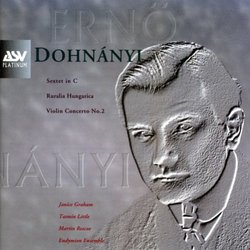| All Artists: Dohnanyi, Janice Graham, Tasmin Little, John Farrer, English Sinfonia Title: Violin Concerto No. 2 / Ruralia Hungarica / Sextet in C Members Wishing: 0 Total Copies: 0 Label: Asv Platinum Release Date: 8/27/2002 Genre: Classical Styles: Chamber Music, Historical Periods, Classical (c.1770-1830) Number of Discs: 1 SwapaCD Credits: 1 UPC: 743625850727 |
Search - Dohnanyi, Janice Graham, Tasmin Little :: Violin Concerto No. 2 / Ruralia Hungarica / Sextet in C
 | Dohnanyi, Janice Graham, Tasmin Little Violin Concerto No. 2 / Ruralia Hungarica / Sextet in C Genre: Classical |
Larger Image |
CD Details |
CD ReviewsAn unjustly forgotten composer Robert Badger | Philadelphia, PA | 02/28/2004 (5 out of 5 stars) "Ernst von Dohnanyi (Dohnanyi Erno in Hungarian) was one of the single most important figures in the musical history of his native land. During the period before the war, he was the president of the Franz Liszt Academy of Music, the director of Hungarian Radio, a prominent conductor, and a world renowned composer and pianist. He promoted the works of Kodaly and Bartok, though he was skeptical as to where their works would lead. In his later years, he resumed teaching at Florida State University in Talahassee where composers such as Ellen Taafe Zwilich profited from his instruction.Dohnanyi was a musical conservative. He rejected many of the modern trends, such as serialism which he viewed (rightly in my view) as tremendously destructive. He adhered to classic forms. However, this does not necessarily mean that his later works sound as if they were composed by Schumann or Brahms.In his Second Violin Concerto, we see that the composer's harmonic vocabulary has increased since the time of his First Violin Concerto in 1920. There is a greater use of disonnance. In this work, he is still a master of his craft. This is an exceptionally well written work that deserves a wider public hearing. Dohnanyi also believed in the use of humour in composition, as the second movement of the Concerto bears out.Hopefully, more recordings such as this will lead to the composer's rehabilitation."
|
